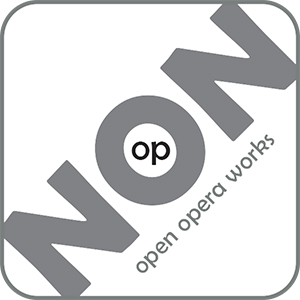HEAR BELOW: Listening to Chicago Underground
A Pedway Soundwalk led by Christophe Preissing of NON:op Open Opera Works and Eric Leonardson of the Midwest Society of Acoustic Ecology with Alex Braidwood of Listening Instruments
February 14, 2020
Report by Christophe Preissing, Eric Leonardson, and Alex Braidwood with Sharon Hoyer, soundwalker.
Listen to an audio montage of the HEAR BELOW Pedway Soundwalk.
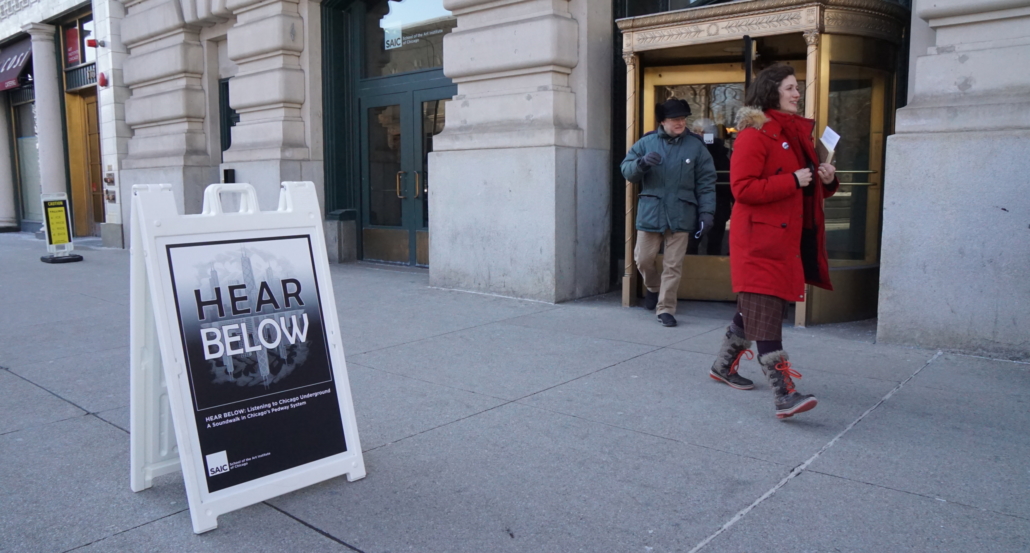
Hearing is constant. We can’t shut our ears the way we can our eyes; sleeping or awake, attentive or distracted, our ears never stop receiving and transmitting sound waves to our brains. Studies have shown that the body does not adapt to noise. No wonder so many of us drift through our commutes with our ears swaddled in cushioned headphones or earbuds jammed into our canals, sonically cocooned against the cacophonous city.
Sharon Hoyer, soundwalker
Walking in the city—and in particular in Chicago’s Pedway System—presents numerous challenges: a patchwork of corridors and chambers, inconsistent accessibility, and the potential for unexpected construction and repairs. Wayfinding in this subterranean world, searching for signs to follow, remembering when and where to turn, and encountering unexpected broken escalators and elevators, tests our capacity to navigate and respond to the environment. For the disabled, wayfinding in the Pedway contains all of these challenges and more. And yet, enclosed by reflective glass and concrete surfaces, not only are we protected from the cold and the rain, the reverberant chambers and corridors can produce nearly musical tonalities and key changes that are noticeable simply by traveling from one underground passageway to another.
The 2020 HEAR BELOW: Listening to Chicago Underground soundwalk was conducted by NON:op Open Opera Works (NON:op) and the Midwest Society for Acoustic Ecology (MSAE), with underwriting support from the School of the Art Institute of Chicago (SAIC), and in kind support from the Chicago Architecture Center (CAC), and World Listening Project (WLP) in connection with the College Arts Association’s 108th Annual Conference. This year’s soundwalk was led by teaching artists Eric Leonardson of the MSAE, Christophe Preissing of NON:op, and Alex Braidwood, an Iowa sound artist and creator of Listening Instruments.
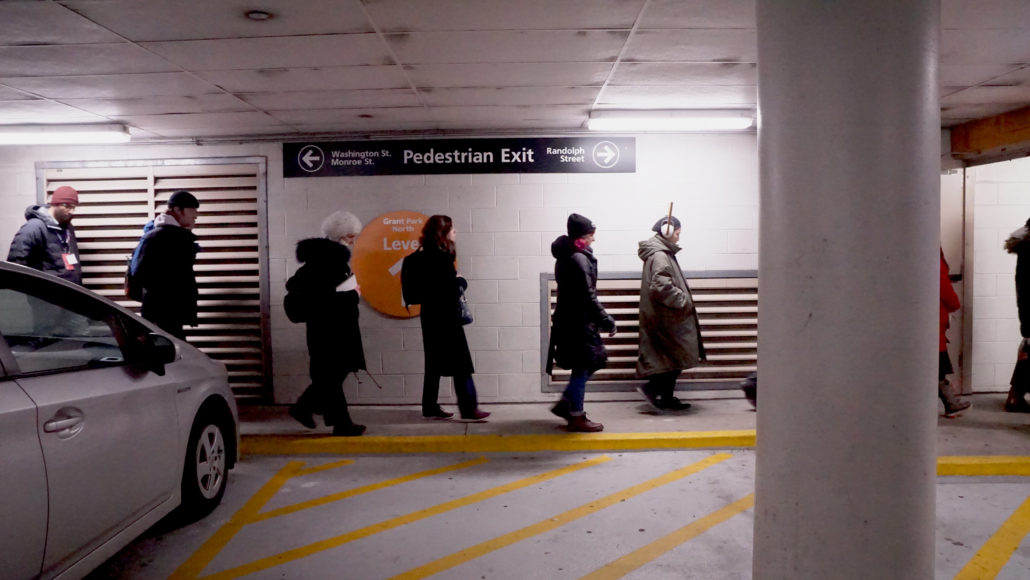
Because the HEAR BELOW soundwalk is entirely indoors, and mostly underground, it is a departure from what many consider a soundwalk: an outdoor walk in an urban or natural environment. However, as many go about their day-to-day urban routines and pass through this most ordinary of places, can we come to a better understanding of the life of the city by listening? If we are open and attentive to our surroundings, might we witness the ever-changing atmospheres of architectural space, with their rich and varied tones, signals, and noises, and the myriad of human activity and interactions that comprise the city? Though city planners may have had different intentions, this energy makes Chicago’s Pedway System ideal for a soundwalk: a focused excursion to re-engage our listening with our sense of place.
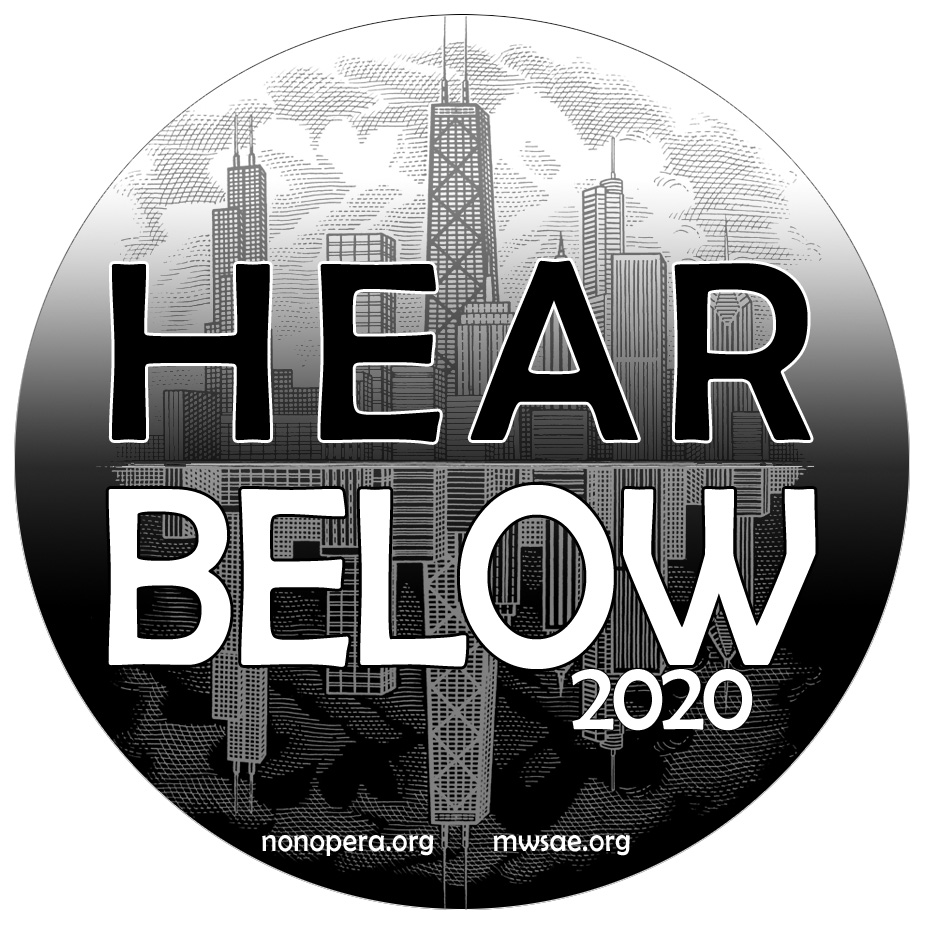 Soundwalkers gathered at SAIC’s MacLean Center, where NON:op board member Wade Wilson and MSAE’s Eric Leonardson handed out HEAR BELOW buttons to identify participants and information sheets for later reflection on their soundwalking experience. Preissing, Leonardson, and Braidwood wore HEAR BELOW branded t-shirts so participants could identify who was leading the soundwalk—necessary for timing, safety, communication, and most importantly, for establishing trust. Given the general novelty of the goals and practices of soundwalking, plus the inherent wayfinding challenges of the Pedway itself, extra attention was paid to planning an accessible route and producing visual aids. At 12:30 we proceeded into the frigid February air, across Monroe Street, and down into the Grant Park North underground parking structure.
Soundwalkers gathered at SAIC’s MacLean Center, where NON:op board member Wade Wilson and MSAE’s Eric Leonardson handed out HEAR BELOW buttons to identify participants and information sheets for later reflection on their soundwalking experience. Preissing, Leonardson, and Braidwood wore HEAR BELOW branded t-shirts so participants could identify who was leading the soundwalk—necessary for timing, safety, communication, and most importantly, for establishing trust. Given the general novelty of the goals and practices of soundwalking, plus the inherent wayfinding challenges of the Pedway itself, extra attention was paid to planning an accessible route and producing visual aids. At 12:30 we proceeded into the frigid February air, across Monroe Street, and down into the Grant Park North underground parking structure.
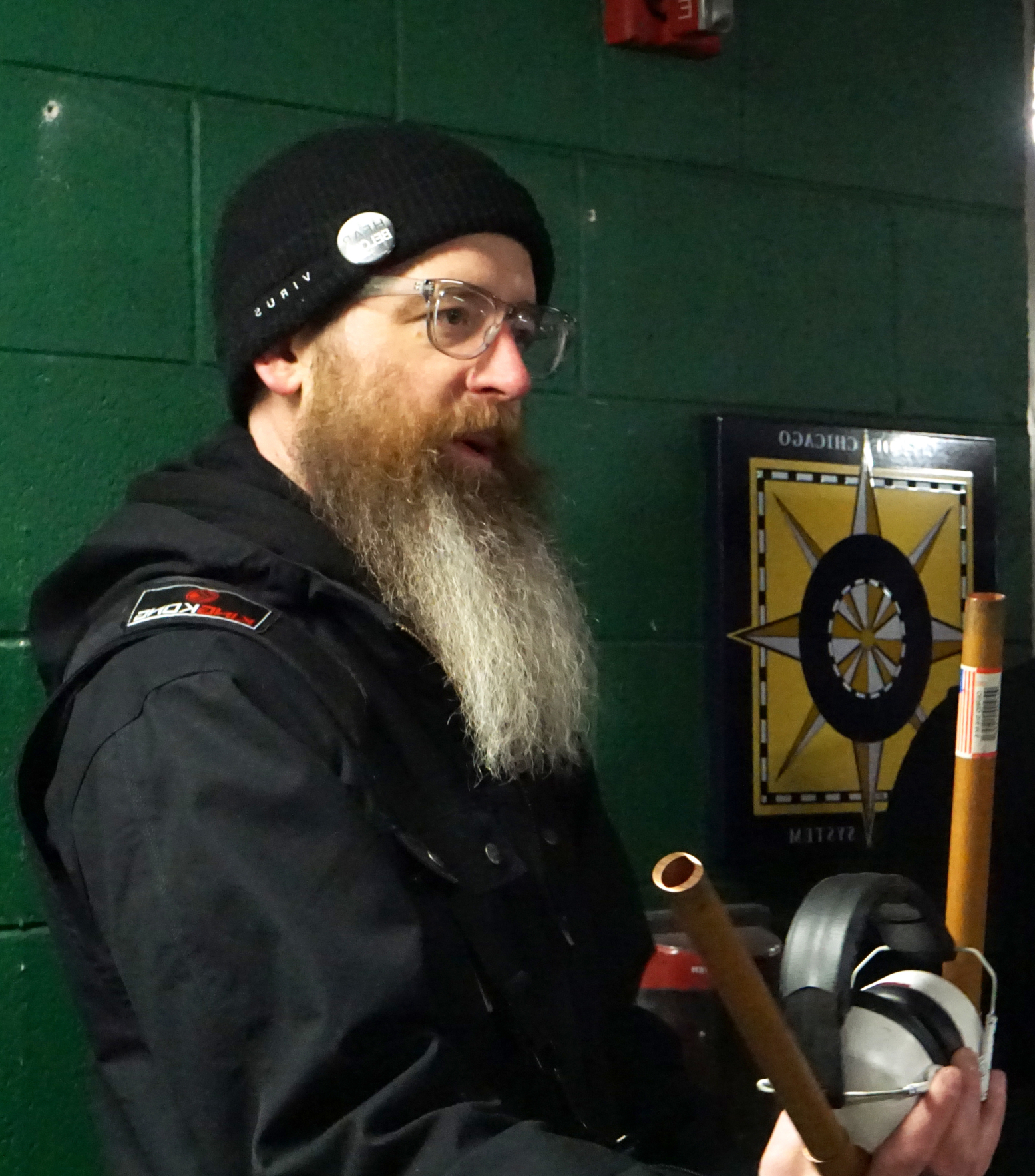 Christophe Preissing welcomed the 40+ soundwalkers to the soundwalk and introduced Eric Leonardson, who led a few simple exercises to provide a “sensory reset” and set the tone for members of the group. By closing our eyes, taking some slow, deep breaths, and listening for the nearest and the farthest sounds we could hear, we shifted attention from our daily lives, to the sounds we most often ignore. That vast amount of information–including our own perceptions of it—we refer to as the “soundscape”. Alex Braidwood spoke about the Listening Instruments, which are constructed from over-the-ear earmuffs and various lengths of copper tubes. Because only six pairs of Instruments were available, they were distributed to participants as a shared resource to enjoy their fascinating acoustic effects. Then Preissing described the route that he and Leonardson had mapped the previous summer—north along the Grant Park parking, through the Millennium Park train station and the Prudential II lobby, under the AON Center and two hotels, concluding in the Chicago Architecture Center’s Gand Lecture Hall.
Christophe Preissing welcomed the 40+ soundwalkers to the soundwalk and introduced Eric Leonardson, who led a few simple exercises to provide a “sensory reset” and set the tone for members of the group. By closing our eyes, taking some slow, deep breaths, and listening for the nearest and the farthest sounds we could hear, we shifted attention from our daily lives, to the sounds we most often ignore. That vast amount of information–including our own perceptions of it—we refer to as the “soundscape”. Alex Braidwood spoke about the Listening Instruments, which are constructed from over-the-ear earmuffs and various lengths of copper tubes. Because only six pairs of Instruments were available, they were distributed to participants as a shared resource to enjoy their fascinating acoustic effects. Then Preissing described the route that he and Leonardson had mapped the previous summer—north along the Grant Park parking, through the Millennium Park train station and the Prudential II lobby, under the AON Center and two hotels, concluding in the Chicago Architecture Center’s Gand Lecture Hall.
This year’s route, similar to last year’s inaugural walk, featured multiple different spaces, each with their own unique acoustic signature. As we passed block by underground block through the cavernous parking structure, the sound atmosphere shifted, changing soundwalkers’ perceptions of the otherwise drab, utilitarian “rooms”. We came upon an active construction site that “announced itself from a football field-length away.” (Sharon Hoyer) This was not under construction when the route was planned! It offered some amazing sounds and sights, at one point a low frequency blower howling and a jack hammer crackling accompanied by billowing, milky plastic surrounding a 50+ square foot space created an intense multisensory experience, buzzing our bones and assaulting our ears. Sharon described the sound:
The noise ricocheted off every surface, initially sounding like a growling beast, some massive piece of motorized equipment. As we approached the source and the distortion gradually lessened, the racket transformed into the deafening, rapid-fire crack of a lone jackhammer.
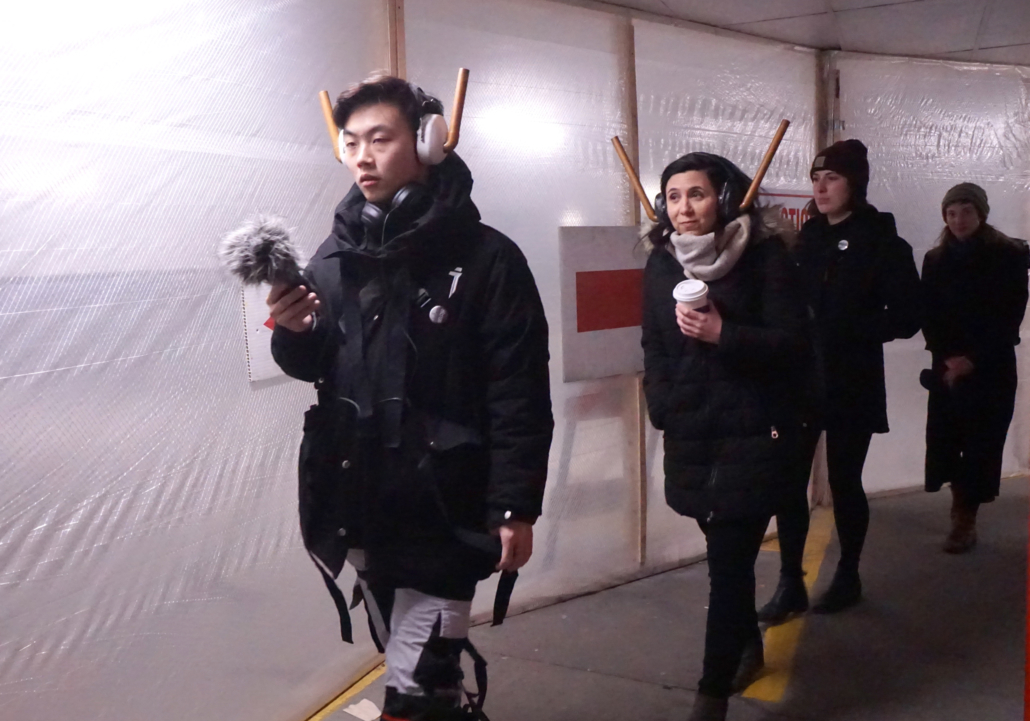
As we progressed around the construction site and up a switchback ramp, the demolition sounds subsided, jackhammer cross fading into the snoring of a homeless person—a reminder of the inequities inherent in our socio-economic system. A long, dark hallway opened up to the South Shore Line interurban rail platform. Pops, clicks, and hums of the electrically powered trains filled the air, complimented by hydraulics, doors, and a rolling suitcase. We paused there to discuss what we were hearing and to assess the state of the group, then poured into Millennium Park station where we were met with another abrupt sound signature that included the sounds of commerce, muzak, and a throng of passengers crisscrossing the station.
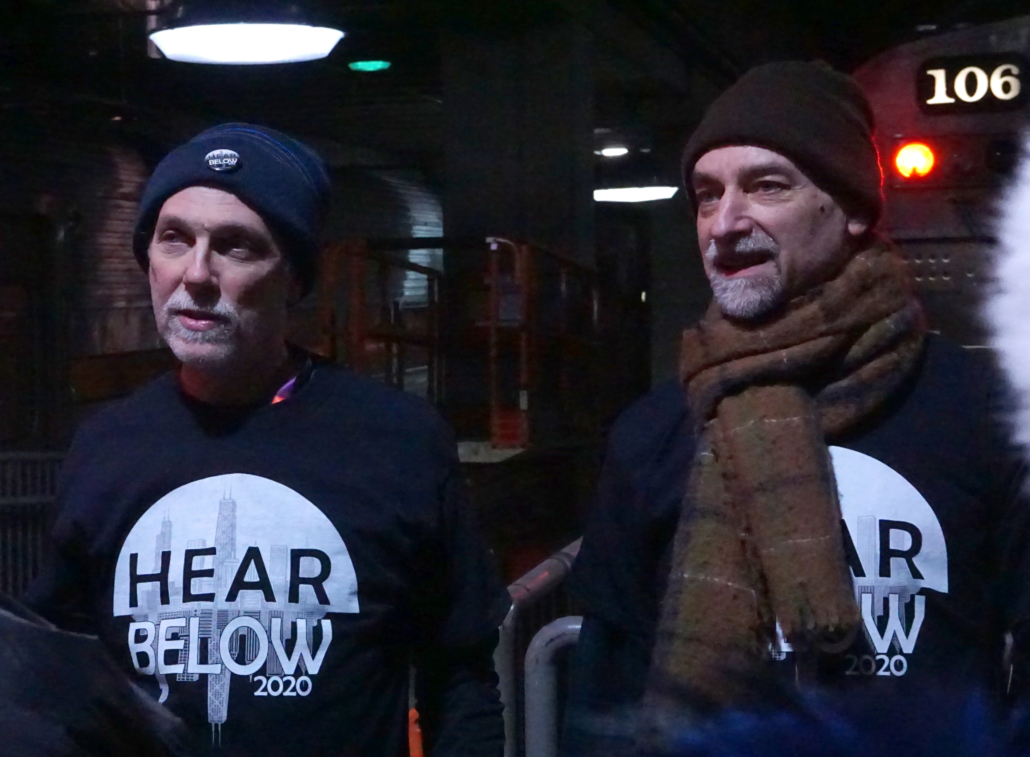
From there, the original plan was to take the escalator up to the spacious Prudential II lobby. However, the soundwalk leaders had not noticed the absence of an elevator. Instead, we decided to continue north, pass through the south lobby of the South Water Street Metra station and walk along the platform. As participants approached the north end of the tracks, a polyphony of voices beckoned: “This is Track Number Three.” “This is Track Number Five.” Unknown and disregarded by most non-disabled passengers, these audible track identifiers are a disability accommodation for those who are blind or low vision. They remind us that inclusion enhances the sound environment, and likewise, that numerous entrances and stops remain inaccessible, excluding many people with disabilities from the public transportation system.
Participants gathered again in the north lobby of the South Water Street Metra station for a brief conversation about what we heard and experienced since our last stop. Preissing gave instructions on the rest of the route, and we proceeded out of the lobby and up to street level in an old creaky elevator. Though some preferred to take the stairs, those who chose the elevator were audience to another unique listening experience: mechanistic rhythms and visuals suggesting decaying infrastructure.
Outside the elevator participants walked south through the Illinois Center lobby, up another set of elevators to the second level, and doubled back north and through the shopping concourse. Sharon described her experience:
The final leg of the tour took us from the South Water Metra Station up through the levels of Two Illinois Center, which was the aural equivalent of ascending too quickly from a scuba dive. As we rose from the subterranean, infrastructural level to the bustling food court, the sonic landscape abruptly shifted from low and rumbling to bright and raucous: hundreds of people fast-walking the halls, talking on phones or eating in the gauntlet of restaurants on the mezzanine that assaulted our noses even more than our ears. The half hour of attending closely to one sense seemed to increase the sensitivity of the others as well. I realized that my habit of shutting out the sounds around me on my commute with music or podcasts was a form of self-impairment, like walking through the world with my dominant hand tied behind my back. Navigating the bustling mezzanine, I felt hyper-alert, like a thin veil draped over the world that dulled and muffled everything around me had been lifted. The effect was stimulating. Almost overwhelmingly so.
At the Potbelly Sandwich Shop, we turned right to take an elevator down to the Chicago Architecture Center. Because of the elevator’s size, some took the stairs but were frustrated by a dead end. Again, we discovered that wayfinding in the pedway is a constant challenge.
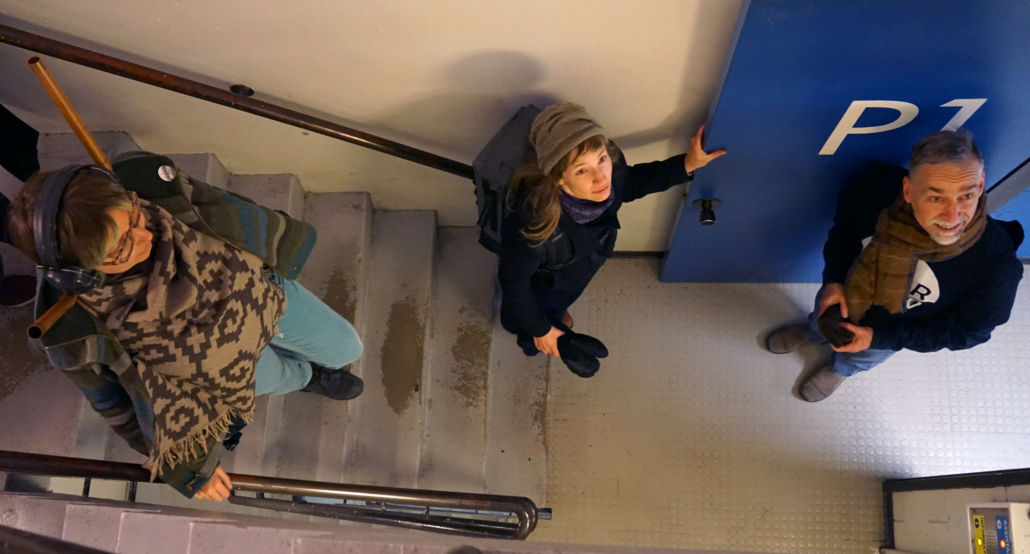
Exiting the elevator, soundwalkers entered the Chicago Architecture Center’s Joan & Gary Gand Lecture Hall, where CAC’s Madison Smith welcomed and introduced everyone to the CAC and its mission. This led to a lively discussion with Preissing and Leonardson, in which participants reflected and expressed their observations of what they heard, and what they learned about themselves and the city by listening to the Pedway.
While the soundwalk’s leaders emphasized listening for different acoustic signatures and marks of the diverse spaces we passed through, one participant noted a kind of sensory—aromatic and visual signatures and marks were as powerful as the acoustic ones. Additionally, each space along the walk contributed to proprioception, or the awareness of the position and movement of our body in space.

Many participants were keen to reconsider architecture beyond the visual. The ensuing discussion around the social functions of public space in relation to privilege, income disparity, homelessness, mobility, and safety for women, minorities, and the disability community, gave greater clarity to how these intersect with access to public space, resources, and socio-economic opportunity. Sharon observed:
Attendees made thoughtful observations about the sonic difference between the lower, operational levels of the city and the higher levels of habitation and city life. One attendee commented on the person sleeping near the construction zone and how the repellent nature of the noise provided them a space to sleep undisturbed; she commented on the luxury of silence, and how the sonic environment is, in a city, determined by class.
Soundwalkers who wore Alex’s Listening Instruments were astonished by the timbrel shift produced without electronics. The different length copper tubes filter different frequencies, and along with the wearer’s head movement, the ambient soundscape is enriched, with one’s attention becoming more focused on hearing. The Listening Instruments also added a level of performativity to our soundwalk by visually announcing our presence. Passersby, many of whom were enveloped in their own acoustic bubbles, were confronted by a novel approach to listening.
For at least one participant, HEAR BELOW was a new experience, for another happy participant, it changed their viewpoint on the arts in Chicago. Another participant felt a sense of inner calm that came with being attuned to the ecology of sound. For others, it was a chance to meditate on what makes the city exciting or even dangerous while being in a safe place or group.
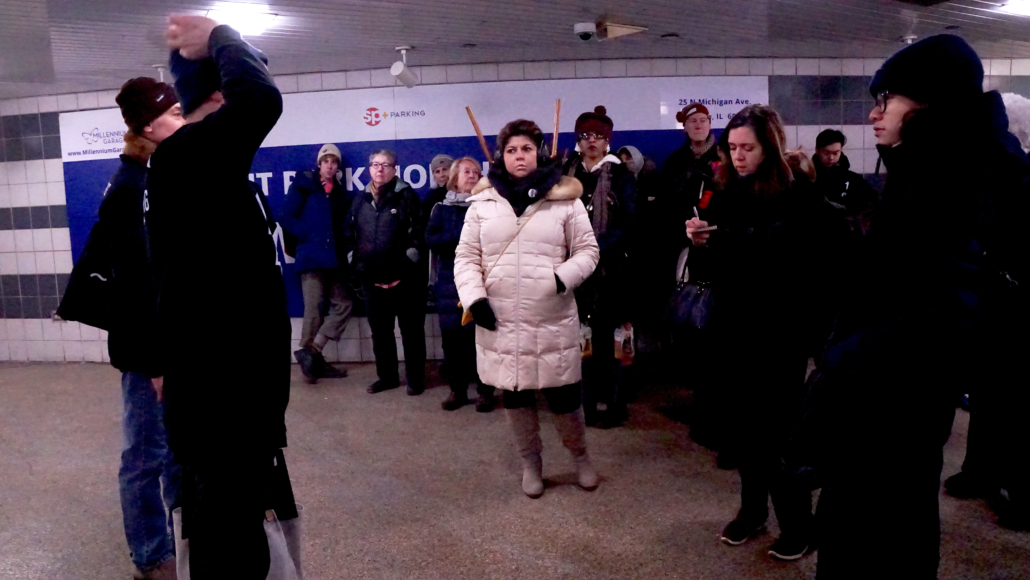
In our predominantly visual culture, the value of listening is often ignored. A soundwalk offers a rare and non-invasive auditory interaction with a place, within an attentive and safe community, however temporary or transitory. During the post soundwalk discussion, the otherwise interior listening experience and dynamic relationships each individual had with the environment were outwardly shared and yielded surprising commonalities given the inherent subjective nature of listening. Perhaps, by shifting our focus from viewing to listening we may begin to appreciate the social exchange and engagement of the soundwalk as art. Sharon summed up her experience:
When the event concluded, I stepped outside feeling a sense of inner calm that comes with being attuned to what Leonardson referred to as the ecology of sound. Instead of popping in noise-cancelling ear buds, I quieted my internal dialogue and, walking to the train, listened.
Thanks to all of Hear Below’s teaching artists and sponsors:
Christophe Preissing & NON:op Open Opera Works
Eric Leonardson & Midwest Society for Acoustic Ecology
Alex Braidwood/Listening Instruments
World Listening Project
School of the Art Institute of Chicago
Chicago Architecture Center / Joan & Gary Gand Lecture Hall
For more information on related topics:
World Forum for Acoustic Ecology
Acoustic Ecology
Field Recording
Deep Listening/Pauline Oliveros
Soundscapes/R. Murray Schafer
Soundwalking/Hildegard Westerkamp
Wayfinding
